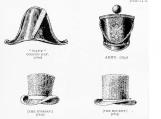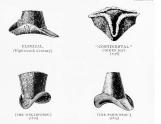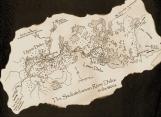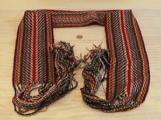1
Fur Trade EraIn 1690 Henry Kelsey traveled up the Saskatchewan River, over-wintering near the present site of The Pas. The first European to visit the area, young Mr. Kelsey was scouting the country for fur trading opportunities for his employer, the Hudson's Bay Company (HBC). His visit marked the vanguard of the fur trade - a massive commercial enterprise that was to dominate the region for 200 years and shape the nation of Canada.
3
The Fur Trade was an industry based on a fashion trend. In the seventeenth century, every European of style and note wanted a beaver hat. But this was not some furry headgear - it was a hat made of felt from the undercoat of the beaver's pelt. This fine dense fur, consisting of thousands of short barbed hairs, could be pressed into a glossy felt that was waterproof and could be easily worked into a variety of styles. These included military styles such as the 'Continental', 'Army', 'Navy', 'Clerical', 'Paris Beau', and 'Wellington', and civil styles - top hats like the 'D'Orsay' and the 'Regent'.6
The Saskatchewan River played a crucial role in the fur trade as a major transportation route from the vast trapping regions of the northwest to the various seaports shipping to Europe. The majority of pelts from the prairies and foothills via the North and South Saskatchewan Rivers, and from the Churchill River basin and the immense Athabasca region funneled down the Saskatchewan River.Beyond it's mouth at Lake Winnipeg, the European bound routes diverged, with the brigades of the HBC going northeast down the Hayes River to York Factory on Hudson Bay, while the voyageurs of the NW Co. and others traveled on through the Great Lakes to the port of Montreal.
7
In the early days of the trade, the Hudson's Bay Company collected furs from native trappers who made the long and arduous trip to trading posts on Hudson Bay. As the trade grew, however, independent traders and the coureurs de bois of the North West Company pressed inland and intercepted the trade by dealing closer to home for the trappers.With a dwindling share of the trade coming down-river to their posts on the Bay, the HBC sent Samuel Hearne to the Saskatchewan River in 1774 to establish their first inland trading post. Hearne's instructions were to build at a site known as Basquia [current day The Pas], but found the site was stripped of suitable timber by a long history of use. As well, the local Cree people convinced Hearne that more trappers would trade at the post if it were established further upstream around Cumberland Lake.
Hearne chose a spot on Pine Island for the post of Cumberland House. The site was strategically placed on Cumberland Lake to meet traffic coming down both the Saskatchewan and Sturgeon-Weir Rivers.
8
The quest for furs led to the exploration of the far reaches of the North American continent by Europeans. The Aboriginal people were already familiar with the rivers and routes of their home territories and with the habits of the beaver and other fur-bearing animals of the forest.Acting as guides and trappers, they became partners in the fur trade enterprise, trading furs for items that were new to their culture - metal goods such as knives, kettles and guns, glass beads, cloth and fabrics. In many cases Aboriginal people acted as middlemen in the trade, dealing with trappers from more outlying regions and transporting furs to the company posts.
10
The VoyageursThe fur trade was carried out by the stamina and strength of the 'voyageurs'. A hearty breed of men, the voyageurs could still find the breath to sing after a day of paddling and portaging that began before first light at 3:00 a.m. Their paddling cadence of forty to sixty strokes per minute was only broken for portages, or for the hourly break called a 'pipe'.
Fuelled by meals of buffalo pemmican, the endurance and stamina of the voyageur was best illustrated on the portage. The typical cargo of fur pelts was bundled into 90-pound 'pieces' and the usual practice was for the voyageur to carry two 'pieces' on the rugged portage trail.
The most famous voyageurs were the French Canadians - the 'Canadiens' or 'engagés', usually recruited from the farms and villages near Montreal.
The hand-woven brightly coloured sash, (ceinture flèchée), was worn as a common article of dress among the voyageurs. Not only decorative, the sash also gave abdominal and back support to bodies that were routinely carrying loads of 180 pounds over rough terrain. The multi-coloured sash has become an enduring symbol of Métis history and culture.
12
The MétisThe fur trade led to the birth of a new nation - the 'Métis' - offspring of the blending of two races and cultures. Many of the European traders and voyageurs over-wintered in the 'pays d'en haut' - literally the 'high country' meaning the wilderness north-west of Lake Superior. Here they learned the ways of the forests and rivers from the native trappers, and worked and lived alongside them. Many took native wives and had families.
The Métis nation has become a strong cultural strand in the fabric of western Canada today. Cumberland House and Cormorant in the Lower Saskatchewan River area are two proud examples of vibrant Métis communities.
13
Métis family: Isabel Ledoux, her husband, Michel Chartrand and their two sons1900
unknown location

14
The Hudson's Bay CompanyThe Hudsons's Bay Company (HBC) was formed when two coureurs de bois defected from the French Fur trade in New France to London to entice King Charles II to form a company that would exploit the rich fur resources in the Hudson Bay region of North America. On May 2, 1670, Charles II of England authorized a Royal Charter that created "The Governor and Company of Adventurers of England trading into Hudson's Bay". The King placed his cousin Prince Rupert in charge of this endeavor, and granted the company trading rights to "Rupert's Land" - all the lands drained by rivers flowing into Hudson Bay - an immense area that covered almost half the continent.




